
Yamini Krishnamurthy in New Delhi in 2011.
| Photo Credit: V.V. Krishnan
Renowned classical dancer and choreographer Yamini Krishnamurthy passed away on August 3 after a prolonged illness. She was 83.
Her mortal remains will be kept at the Yamini School of Dance in Hauz Khas in Delhi on August 4 for her students and admirers to pay their last respects.
Ms. Krishnamurthy is credited with popularising Bharatanatyam in North India, as early as in the 1960s, when she chose Delhi as her home. Not content with this, she strived hard to take the dance form to the global stage, and like sitar maestro Pt. Ravi Shankar became a sought after name internationally.
Known for her vibrant approach, Ms. Krishnamurthy’s dance sparkled with energy.
Yamini Krishnamurthy (1940-2024)

A file picture of dancer Yamini Krishnamurthy with Shehnai maestro Ustad Bismillah Khan.

The doyen of Kuchipudi, Bharatanatyam and Odissi Yamini Krishnamurthy had been practicing classical dance since her childhood.

Yamini Krishnamurthy grew up in Chidambaram in the Cuddalore district of Tamil Nadu.

The dancer has procured the prestigious Padma Shri, Padma Bhushan and Padma Vibhushan awards.

Yamini learnt Kutchipudi under great teachers like Vedantam Lakshmi Narayana Sastry, Pasumarthi Venu Gopal Sharma, Chinta Krishnamurthy and Vedantam Satyanarayana Sharma.

Yamini Krishnamurthy had always been awed by various postures of Nataraja and sculptures on temple walls.

Yamini Krishnamurthy trained in Bharathanatyam at Kalakshetra (Madras) under Rukmini Devi Arundale.

Yamini lived in New Delhi and ran the institute named Nritya Kaustubha.

At the age of 17, Yamini Krishnamurthy gave her first solo performance in 1957.

Yamini Krishnamurthy, performing Bharatnatyam for the aid of poor kidney patients organised by Swar Rang.

Pandit Birju Maharaj and Yamini Krishnamurthy at a function in New Delhi on Friday.

Yamini Krishnamurti is renowned for her elegant stage presence, sculpture-like stance, expressive eyes.
1/3
Though she trained under great masters of the time, she lent her own distinct touch to the technique without diluting the grammar. Her stances, facial expressions and movements were strikingly precise. She inspired generations of dancers to pursue the art form.
She was born on December 20, 1940 at Madanapalle in Andhra Pradesh. Her father was a Sanskrit scholar and her grandfather was an Urdu poet. Her training in Bharatanatyam began at a very early age at Kalakshetra in Chennai. After mastering the basics, she learnt from eminent gurus such as Kanchipuram Ellappa Pillai, Kittappa Pillai, Dhandayuthapani Pillai and Mylapore Gowri Ammal.
She also gained proficiency in Kuchipudi under Vedantam Lakshmi Narayana Sastri and Chinta Krishnamurthi. A versatile artiste, she learnt Odissi from Pankaj Charan Das and Kelucharan Mohapatra.
Chidambaram days
The dancer, whose debut performance was in 1957 in Chennai, always spoke about the days she spent as a five-year-old in Chidambaram, and how the town, famed for the Lord of Dance Nataraja, drew her to the art.
“She ruled the dance world for a long time and the high standard she set as a soloist is hard to surpass. She was the go-to dancer when it came to prestigious national and global events. Like M.S. Subbulakshmi and Ustad Bismillah Khan, she became a cultural ambassador. Along with her scholar-father, she explored both the philosophical and spiritual aspects of the art. With her father’s guidance, she gathered amazing material to mount her dance on. Though her last days were spent in loneliness, she did not lose her love for dance and was always eager to know what was happening. It’s a great loss to the artiste fraternity, but her life will continue to serve as a valuable lesson,” said Geeta Chandran, a Delhi-based Bharatanatyam dancer.
People were often struck by her arresting presence. “Her eyes spoke a lot. She had an aura about her. When you met and spoke to her, you realised that she was a born artiste,” says Chennai-based Bharatanatyam dancer Priyadarsini Govind.



